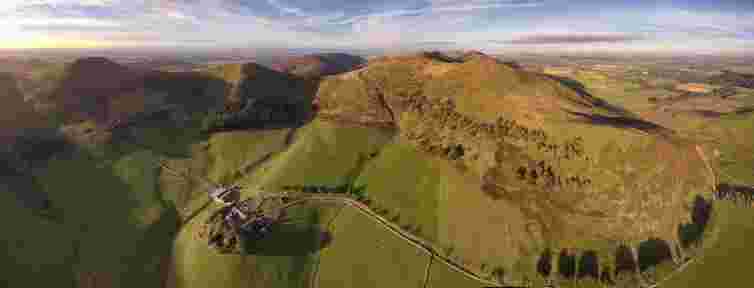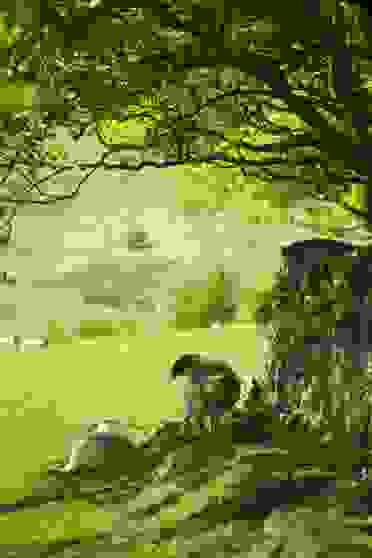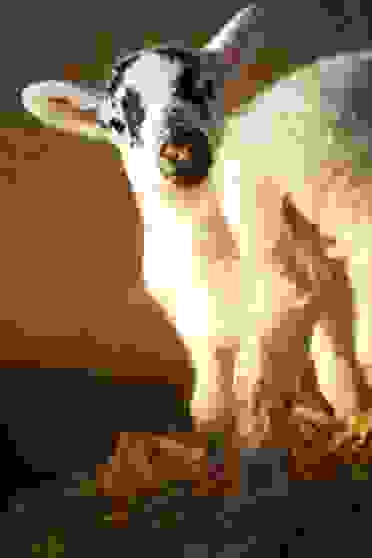Mid April & into May | Lambing time in the hills
With 1400 breeding ewes lambing from mid April, it’s a busy time. Many of our sheep are lambed on the hill, the rest in 'in-by' hill paddocks, far more content on home turf. We check throughout the day finding hilltops and promontories where we spy from afar with binoculars to see if all is well, disturbing the ewes only when we think something is wrong. Anything from a ewe or lamb not looking right, to lambing trouble, lost or hungry lambs or just forgetful and careless mothers!
In this job we are always intrinsically connected to the weather and the changing seasons. Lambing outdoors can be wonderful on a dry warm spring and conversely hard graft for both sheep and shepherd during a late spring snow storm. In the hills we farm the Scottish Blackface sheep, native to the heather hills of Scotland. For the most part the ewes lamb unaided with healthy lambs on their feet and drinking the ewes first milk within a few minutes.
Any new born lambs that are a bit slower to get to their feet will need bought in from the hill to the farmstead. There the lamb will be warmed, if hypothermic, in the farmhouse kitchen and assisted in feeding from its mother every 4 hours until fully recovered and drinking well independently. There is a huge amount of job satisfaction in watching the change from poorly lamb to a frolicking one.
Looking out
Every year we are grateful to the public for ringing in potential problems or dropping in to the farmhouse. It helps us to have so many eyes in the hills looking out for the ewes. If anyone spots anything amiss, please let us know on 01968 677842. Thank you!
2022
We have the odd early lamb gambolling about thanks to an escapee tub but are not due to start proper until mid April. Fingers crossed for warm days and lots of grass.
2021
We come to spring after a hard winter. 7 weeks of full snow cover coupled with severe disturbance as lockdown was eased made for an uneasy start. The snow left but the cold continued long into the year, SRUC recording a 3 week delay on soil temperature and grass growth.
Late April and the sun has finally brought the grass. A bad winter can mean an easier lambing with small lambs making easier births. We have made a good start under good weather, long may that continue...
__________________
Looking back we did have a lot more issues than usual as ewes from the more disturbed covid-snow-sports hills came into spring far poorer than their neighbouring hills. Onwards and upwards though and fingers crossed the pandemic keeps moving in the right direction.
2020
A wonderful warm dry spring suited the sheep well. The grass grew early with a couple of the old mossy pastures put under plough and reseeded with a regenerative mix full of old fescues that suit this altitude far better. The hills were eerily quiet with full lockdown in place throughout lambing. We waved to locals and neighbours, the lucky ones able to access the hills, as we did our rounds.
The quiet hills made for an exceptional year for the ground nesting birds. The red grouse and curlew numbers come late autumn had rocketed. A good year for the Kestrel as well. A 'good vole year' meant that all six chicks fledged from the nest on the Moss. We were honoured to meet the young birds during tagging where they are weighed and measured. The hills provide a nursery for many a species beyond the sheep we shepherd.
2019
With warm dry spring weather lambing this year was wonderful. The grass both in-by and out on the hill grew well, easily sustaining the ewes during late pregnancy and lambing. When a flush of grass comes relatively early we can have problems with ewes lambing large lambs so take extra care to check and (only when necessary) catch the ewes if they find themselves in difficulty.
It has been a good year for the Curlew as well as the sheep with three nesting pairs on the Low-end alone. Today eight goslings were following their mother over the reservoir, the wild hill hyacinths are flowering and the trees all in leaf. Most came into leaf a good few weeks early with the Ash a hairs breadth before the Oak. If you believe the old folk :'Ash before Oak you're in for a soak', but no sign for the rain clouds thus far.
One of our pet lambs, a two year old ewe or gimmer called Brenda lambed for the first time this spring. She is instantly recognisable by her stumpy horns and was born but abandoned in a terrible spring blizzard. She is showing great mothering skills considering she has been an orphan from birth.
2018
After a blizzard this Easter, we are hoping the weather gets significantly warmer from now onwards. Due to the terrible winter and multiple “Beasts-from-the-East” the ewes were all being given high-energy feed blocks to make sure they are getting the nutrition they need for themselves and their growing lambs.
Usually the ewes are brought into the 'in-by' hill fields in the valley at Eastside to lamb on the new grass. This also makes it easier for us to monitor with all your births and tentative first steps contained there. This year there simply isn’t enough grass in the fields so we are lambing on the hill. The ewes, for the most part, lamb well on the hill, always finding the best shelter and feed on their home turf. It is the shepherd that has a lot more ground to cover with lots more hilltops, gullies and hiding places.
Ali found pet lamb 'Arthur' this year on the hill. He had been abandoned by his mother, which sometimes happens with Blackface ewes if they’ve had a hard spring and know they cannot support the lamb. Although poorly to start with, Arthur is now loving life and is a regular visitor to the farmhouse kitchen - much to the bemusement of the labradors!
The farm throughout the year
For more pictures and information about farming life throughout the year see our on your doorstep page for farming & walking in the Pentland Hills.









